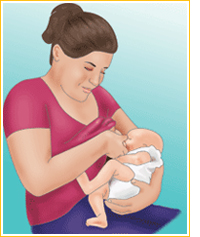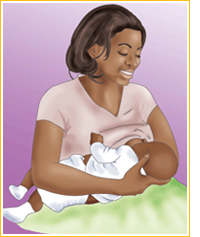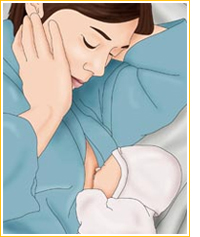Some moms find that the following positions are helpful ways to get comfortable and support their babies in finding a good latch. You also can use pillows under your arms, elbows, neck, or back to give you added comfort and support. Keep in mind that what works well for one feeding may not work well for the next. Keep trying different positions until you are comfortable.
 Cradle hold –
Cradle hold –
An easy, common hold that is comfortable for most mothers and babies. Hold your baby with his or her head on your forearm and his or her whole body facing yours.
 Cross cradle or transitional hold –
Cross cradle or transitional hold –
Useful for premature babies or babies with a weak suck because it gives extra head support and may help babies stay latched. Hold your baby along the opposite arm from the breast you are using. Support your baby’s head with the palm of your hand at the base of his or her neck.
 Clutch or “football” hold –
Clutch or “football” hold –
Useful for mothers who had a c-section and mothers with large breasts, flat or inverted nipples, or a strong letdown reflex. It is also helpful for babies who prefer to be more upright. This hold allows you to better see and control your baby’s head, and keep the baby away from a c-section incision. Hold your baby at your side, lying on his or her back, with his or her head at the level of your nipple. Support baby’s head with the palm of your hand at the base of the head. (The baby is placed almost under the arm.)
 Side-lying position –
Side-lying position –
Useful for mothers who had a c-section or to help any mother get extra rest while the baby breastfeeds. Lie on your side with your baby facing you. Pull your baby close so your baby faces your body.